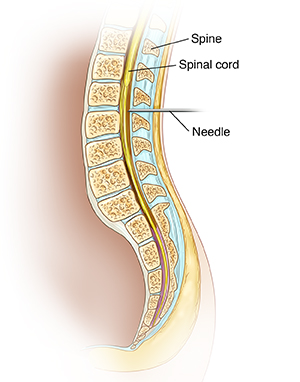Nerve Block for Pain
The pain of an injury or after surgery can be overwhelming. If standard pain medicines don't work, your healthcare provider may suggest a nerve block for pain. This is done by injecting pain medicine called anesthetic into the site of the affected nerve. This injection will block the pain signals the nerve sends to your brain. If your brain doesn't get the pain signals, you won't feel the pain you would normally feel.
Your healthcare provider might also include a steroid in this injection. This will help to control swelling and inflammation around the nerve. This can help with short-term pain, like recovery from surgery or injury, or acute pain from damage to the soft organs. It's also often used along with other treatments for chronic joint and nerve pain.
How a nerve block for pain is done
Your healthcare provider might want to do 1 or 2 nerve block tests to find out the best place to inject medicine to control pain. This means the medical team will inject the anesthetic close to the nerve most likely to carry pain signals from the injured area to the brain. If that works to relieve your pain, that is where the full nerve block will be used.
If your pain is not eased, your provider may try another location. A nerve block may be done with an ultrasound or CT scan. This is to ensure the needle is in the right place. You may be asked to stay still as the needle injects the medicine. You may have a pinching feeling when the healthcare provider does this. Tell the provider if you have severe pain during the procedure.
Types of nerve blocks for pain

These are common types of nerve blocks:
-
Epidural. Many pregnant people get an epidural to ease the pain of labor and childbirth. If you have severe pain in your neck, back, or leg because of inflamed or pinched spinal nerves, your healthcare provider may inject a steroid into the epidural space. This is the space near the spinal canal. The injection may be guided by moving X-ray images. A steroid is often used along with an anesthetic. The steroid may be cortisone. It helps reduce inflammation in the area.
-
Facet joint. Facet joints are the small joints found between each vertebra on your spine. Injections of a steroid with local anesthetic into the facet joints in the spinal bones (vertebrae) can help treat back pain from arthritis or injury. Pain in the neck, middle back, low back, buttocks, or upper legs can be controlled in this way.
-
Sacroiliac joint. The sacroiliac (SI) joint connects the lower spine with the pelvis. Injecting a steroid with local anesthetic medicine into the SI joint can block pain in the buttocks, upper leg, and low back.
-
Suprascapular nerve block. This type of block is done in the shoulder area. It can be useful for chronic pain in the shoulder that doesn't respond to injections in arthritic joints. It can also be used to block shoulder pain that is severe enough to interfere with physical therapy.
-
Occipital nerve block. The occipital nerves are in the back of the head. Injection of a steroid with local anesthetic into these can help ease pain from chronic headaches and types of nerve pain.
Nerve blocks can also be used in these ways:
-
To block pain in a certain area, like the wrist
-
During surgery with local or regional anesthesia
-
After surgery for pain control
Nerve blocks work best if pain is related to a single nerve or a small group of nerves. Other types of pain might not be helped with this approach.
How to get ready for a nerve block
You don’t need any special prep for a nerve block. You may be asked to wear a hospital gown and use the restroom before the procedure. You may lie on your belly, back, or side. This depends on the nerve to be blocked.
Risks of a nerve block
Nerve blocks are considered safe when done by a trained, qualified provider. All procedures have some risks. The risks of a nerve block include:
-
Bleeding
-
Infection
-
Damage to the nerve, causing loss of feeling or strength in the area of the nerve, or more severe pain
-
Itching, swelling, or pain at the injection site
-
Headache
-
Accidental injection of medicine into the blood
-
Muscle weakness or paralysis (rare)
Limits of a nerve block
Nerve blocks can bring relief for a while. But they are not a cure for pain. Their effects may only last for a short time. They are often part of a full program that may include oral medicines, exercise, and stretching to help you recover from your injury.
If you are recovering from surgery, the block should last through the early recovery stages. In other cases, make sure you understand when to call your healthcare provider about breakthrough pain. This is sudden and severe pain that happens even when you are taking medicine for pain.